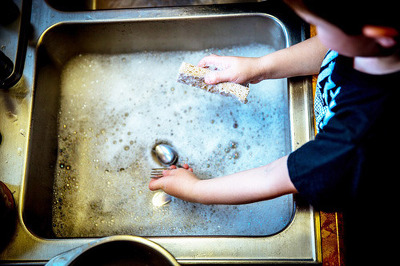
Teaching Kids About Money: Part 2
If you missed our last blog post on laying the foundation of money with your kids, be sure to check it out!
Hands-on practice managing their own money is the best way for kids to develop healthy money habits. Allowances are a great idea and can work many different ways. Typically, kids are paid an allowance for completing specific chores around the house. There’s nothing wrong with paying kids for specific tasks if that’s how you decide to do it, but this isn’t my favorite method.
Kaimey and I felt that paying them for individual chores sets a tone of money motivation in the home. Again, not that it’s bad; we just didn’t want our kids to help around the house so that they would get money. We want to cultivate a heart in them that helps, serves, and does their part to make things run smoothly because they know they are an important part of the family and their work adds value to our home.
I heard from a parent who said their child announced they did not want to do their chores and were okay not being paid anything that week. The parent felt stuck because they had the expectation for the child to do the chores, but they had already set the mindset that chores are completed in order to earn money. And if the kid doesn’t care about money that much, there’s no motivation to do the task. So the expectation to help should be laid first, not using money as a bribe to get them to help.
We also felt like it would be harder for us to keep up with paying them for individual chores. Who did what, who do we owe money to and how much…it’s a lot to pay attention to and stay on top of. And frankly, we knew life would go by and we wouldn’t actually implement this system because it’s complicated.
So our motto is, “If you share in the work of the family, you can share in the wealth of the family.” We repeat it often. Depending on their age and developmental capacity, we have expected them to help with laundry, dishes, pets, cleaning, and lawn care, adding responsibilities as they’re capable. If they have willing hearts to help, pitch in for the work, and show responsibility, they are given a pre-set allowance each week. Hopefully this mindset grows roots and when they’re grown they won’t just view their jobs as something they have to do for money, but teaches them to see how they can help in the world, show initiative, and then be compensated for it.
We began this system when our twins were five years old, giving them $5 each per week. You can use any amount you want, we just chose $5 because it’s easy to break up as follows.
We use the jar method. You may be familiar with it. It’s not our original idea. Our kids each have a spend jar, a save jar, and a give jar. When they get paid each week on Sunday mornings, they get $4 in bills and then $1 as four quarters. They know to put two quarters (10%) in their give jar as their tithe to God and His church. Then they put the other two quarters (another 10%) in their save jar. These things are required! The remaining $4 is theirs to decide which jar(s) to put it in. They can choose to put it all in the spend jar or add additional money to the save jar and/or the give jar. It’s so interesting to watch their personalities in this and ask them how they made their decisions. And a lot of times they are inspiring in how excited they are to put more in their give jar for causes they want to support.
A logistical tip: Go to your bank and withdraw $100 or so and ask for it in $1 bills and quarters. (The first time I did this I got some funny looks asking for a bunch of ones, so feel free to explain yourself!) Then keep the stash as your bank for them somewhere specific in your home. Then you don’t have to continually search for allowance cash. This works for the tooth fairy too!
In theory, we will withhold the kids’ allowance if we feel they have not contributed to work when asked or stayed on top of their responsibilities. Usually, reminders of the expectations are enough. But we also try to balance grace, busyness, sickness, and still reward helpful hearts and attitudes, even if things got crazy that week.
Developing money management skills only works if kids are given the opportunities to spend, save and give as they see fit. It’s empowering for them! And it teaches them to make decisions and prioritize. Since our kids have their own money, we do not give them our money to buy something they want or do something fun with friends. (Theirs was already our money to begin with, right?!) And if there’s a fundraiser at their school, church, or sports organization or a cause that they want to support, they need to use money in their give jar. If the school does a Book Fair or sells t-shirts and the kids would like to purchase something, they use their spending money.
These opportunities are where it gets hard for us as parents. It’s very difficult to stand back and watch your daughter spend $25 on a fidget spinner that has sprinkles on it when there’s a solid colored one for $7 right next to it. This may or may not be from my personal experience. But that’s where the learning comes in–giving them a structure to make those choices and live with the consequences. How important is splurging for the sprinkles? Apparently very important. It’s a growth process for everyone.
Throughout this learning process, you want to continue to influence and help them think through how they use their money. If your child has a hard time with generosity, maybe you have more conversations about that and how wonderful it can be to give. On the flip side, you might have a child who wants to give all their money away or feels like that’s what they “should” do to please you, so you’ll need to have conversations about it being ok and necessary to keep money for yourself. Tell them how you work through the exact same decisions!
As kids get older, you’ll want to build on your money values and practices with them. Eventually, as a next step, we opened savings accounts at the bank in their names, and the kids take their save jars in to deposit when they get full. Each calendar quarter when they receive their bank statements we review it to show them their growth and so they learn how to read a bank statement. In order to teach interest as a reward for saving, we add in 10% of our money to what they have saved each year in their accounts. The next step we will be starting soon is letting them invest it in the stock market and showing them how that works.
No matter how you choose to do allowances or what works in your family, the most important thing is to give it intentional attention. Money is a private subject in our culture, and rightfully so. But you can maintain a comfortable level of financial privacy with your kids and still educate. Just like any other skill and value, neglect is the enemy. And a continual conversation with hands-on practice is always better than a one-time lesson.
Like I said above, there are a lot of different ways to handle allowances with your children. And there is no set right or wrong answer. The important thing is to have the conversations with your spouse, read a book or two, or reach out to a trusted advisor and figure out a system that will work for your family.
Next week on the blog we’ll be wrapping up this series by talking about what skills and financial knowledge kids should have by the time they leave your home. Check back next week!


